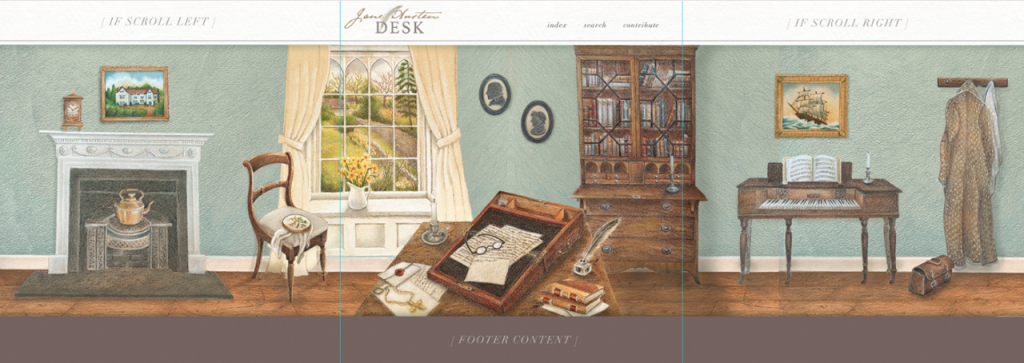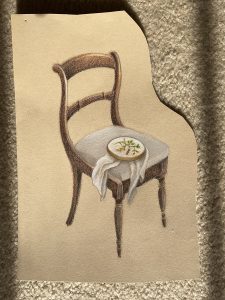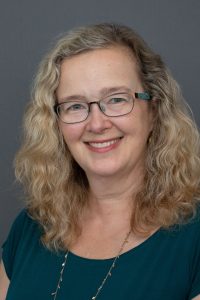A new NEH grant will support UNC scholars’ creation of an immersive web environment designed to bring Jane Austen’s writing room — and her world — to life.

Imagine getting to know Jane Austen better by entering a virtual room modeled after Chawton Cottage, where the beloved author did most of her writing. Scroll around and click on various objects — paintings, a portable writing desk, a quill and more — to delve deeper into her writing and her world.
Principal investigator Inger Brodey and project manager Sarah Schaefer Walton were both inspired by the idea of the old J.K. Rowling website (before the advent of “Pottermore”) in envisioning the digital humanities project “Jane Austen’s Desk.” Brodey is associate professor of English and comparative literature, and Walton is a Ph.D. candidate in that department.

“We loved how you could mouse over, see magic happening and interact with the objects,” said Brodey, whose faculty website features her own virtual desk. “It’s going to feel like a 360-degree view of the room: you can go left and right, up and down, and hover over various objects. For instance, clicking on a painting of a ship will make the ship rock and the waves splash, and it may take you to maps showing the travels of Jane Austen’s family members and illustrate how she traveled vicariously through extensive correspondence with them.”
Point your mouse to Austen’s portable writing desk or “writing slope,” and learn about some of the other locations where she did her writing. The time period for Jane Austen’s Desk focuses on the spring after the publication of Pride and Prejudice in 1813, when Austen was writing Mansfield Park, Brodey said.
Project collaborators also hope to create digital editions of those works — and eventually all her novels — and to collaborate with various groups on annotating them.
“We will also share with users what she was reading at the time. Want to know what inspired her? We’ll link to books and articles so that you can read alongside her,” Brodey said.
Brodey and a multi-institutional team have just received a second grant from the National Endowment for the Humanities for the project. The first was a $30,000 discovery phase grant. This second grant, for $100,000, was announced this month by the NEH and will support development of the protype. The NEH recently awarded $28.1 million in grants for 204 humanities projects across the country; only 15 were given in the “Digital Projects for the Public: Prototype” category.

According to the grant application, focusing on the time in which Austen wrote Mansfield Park will enable the team “to engage with important contemporary issues, particularly issues surrounding female authorship and mobility, the transatlantic slave trade and the Austen family’s disputed role in it, and the family’s involvement in the War of 1812.”
The project builds on the successful Jane Austen Summer Program (JASP), first launched in 2013, and Jane Austen & Co., which launched in 2019 to extend free public humanities programming about Jane Austen’s world. When the pandemic hit, Jane Austen & Co. went virtual, and it continues successfully to this day. There are 30-plus free Zoom episodes in the website’s library, and 10 to 12 new virtual events are programmed each year.
“Hundreds of people sign up for each of these live Zoom talks, especially our popular ‘Race and the Regency’ series, which usually drew attendees from five continents,” Brodey said. Overall, JA&Co, which Brodey co-directs with UNC alumna Anne Fertig (Ph.D. ’21), “has achieved tens of thousands of views.”
JASP has always had a pedagogy component as well; teachers can receive education credits for attending the summer program, and some scholarships are available to cover costs. Through JASP+, a two-day extension of the summer program, teachers can learn more about using digital humanities tools to teach Austen.
Brodey said the prototype phase for Jane Austen’s Desk extends through December 2024; the group will apply for implementation grants with the plan of launching major enhancements in 2025. Scholars from the following institutions will be a part of the project: University of Texas at Austin, NC State University, Auburn University, Arizona State University, Delta State University and Marist College. Harriet Wu, graphic designer for the project, created the artist’s rendering of Austen’s writing room.
Brodey also consulted with UNC’s Digital Innovation Lab and Joseph Viscomi, professor of English and comparative literature and co-creator of the William Blake Archive, in the discovery phase for Jane Austen’s Desk.
Learn more about the project in a recent JASP blog post.
By Kim Spurr, College of Arts and Sciences
